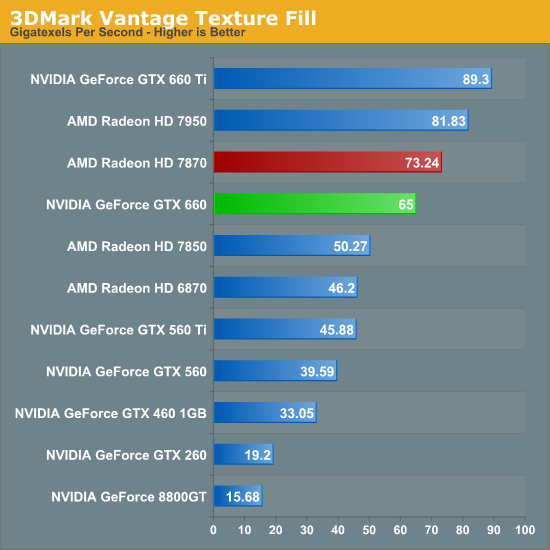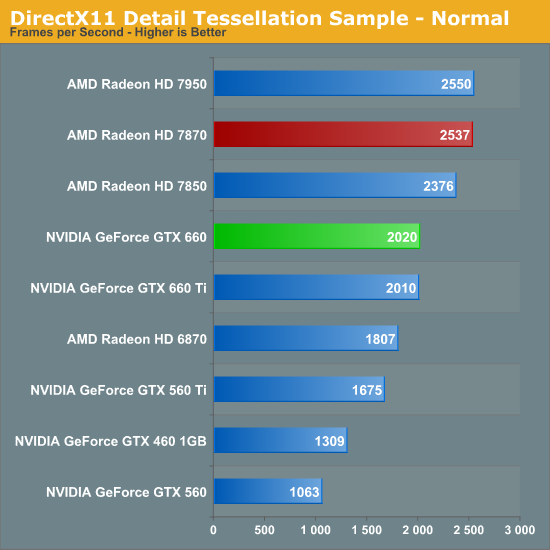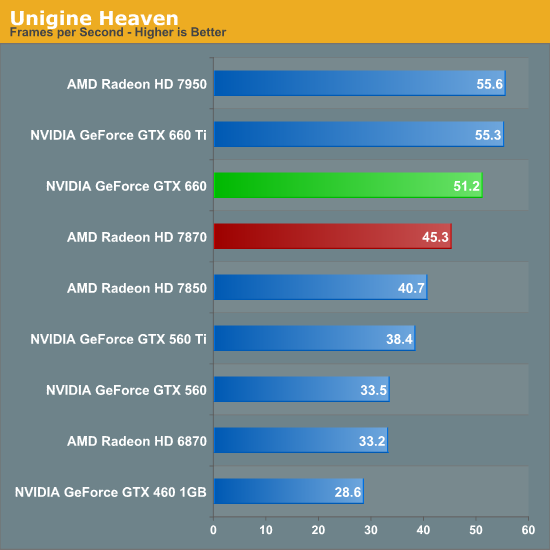The NVIDIA GeForce GTX 660 Review: GK106 Fills Out The Kepler Family
by Ryan Smith on September 13, 2012 9:00 AM ESTSynthetics
As always we’ll also take a quick look at synthetic performance to see if NVIDIA’s core configuration has had any impact on basis performance metrics. We’re expecting to see performance very close to the GTX 660 Ti, due to its nearly identical ROP/L2/memory configuration. We’ll start with 3DMark Vantage’s Pixel Fill test.

3DMark Vantage’s pixel fill test likes memory bandwidth and ROP performance in that order, which makes these results a bit odd. With identical memory bandwidth between them we’d expect the GTX 660 and GTX 660 Ti to at least be tied here, if not a slight lead for the GTX 660 thanks to its higher ROP performance. Instead the GTX 660 trails the GTX 660 Ti by a slight amount, an outcome we can’t explain at this time.

Our texture fillrate benchmark on the other hand sees a large gap between the GTX 660 and GTX 660 Ti, which is what we would expect from the loss of SMXes.
Our third theoretical test is the set of settings we use with Microsoft’s Detail Tessellation sample program out of the DX11 SDK


Despite the loss of SMXes (and thereby Polymorph engines), our tessellation benchmarks don’t show any kind of significant difference between the GTX 660 and GTX 660 Ti. We’ve been finding this benchmark to be surprisingly sensitive to ROP performance and memory bandwidth on Kepler, and these results back that finding.
Our final theoretical test is Unigine Heaven 2.5, a benchmark that straddles the line between a synthetic benchmark and a real-world benchmark as the engine is licensed but no notable DX11 games have been produced using it yet.

Despite its advanced nature, Heaven isn’t particularly sensitive to the loss of shader and texturing performance, as signified by the performance loss of less than 10% for the GTX 660.










147 Comments
View All Comments
MySchizoBuddy - Friday, September 14, 2012 - link
If i'm a new buyer buying the older 560 at a reduced cost both be a better buy correct?Fiercé - Thursday, September 13, 2012 - link
While I may be in the minority, I actually check the "The Test" page of every GPU review in order to see which driver version is being used to test the hardware, as well as to get a quick mental list of 2 or 3 GPUs to watch out for in the FPS comparisons.Due to this I've noticed for this GPU review many cards are listed that don't appear anywhere in the benchmarks:
-AMD Radeon HD 6970
-AMD Radeon HD 7950B (explicitly stated over a non-B)
-AMD Radeon HD 7970
-NVIDIA GeForce GTX 570
-NVIDIA GeForce GTX 670
(Excepting all the GTX 660 Ti that of course can't be re-tested in time for a launch review, but might be useful as a "factory overclocked options" list for a reader looking at base 660 Ti performance.)
Ryan Smith - Thursday, September 13, 2012 - link
Thanks for the heads up. I had copied that out of the GTX 660 Ti article and had not yet edited it. It has been fixed.Fiercé - Thursday, September 13, 2012 - link
Cheers.Jamahl - Thursday, September 13, 2012 - link
That has the 660 faster than the 7870. Most reputable sites have the card squarely in-between the Pitcairns.Rick83 - Thursday, September 13, 2012 - link
It appears to me, that we should be glad, that the jump in performance is that low, as finally it seems the power wars of the last generation, when cards were dumping 200 Watts and more into your case, even when they were just higher mid-end cards, are over.Now of course that means we get slightly less of a performance boost, but at least power consumption of this card is below the level of a GTX260. That is important, as the 560Ti was relatively quite power hungry, especially once the wick on them was turned up a bit, which was being done quite liberally.
While the Performance/Dollar metric isn't that great, the performance/(dollar*power) is probably much better than last gen.
n9ntje - Thursday, September 13, 2012 - link
As everyone said it, nVidia is again late to the party. However, both (amd and nV) haven't done anything to improve the price/performance. First the $100 price range, now the 200?I'm sorry but since I bought my HD5750 almost 3 years(!) ago for 100 bucks. I dont get much more performance with a similair priced card. Now they are doing it the same to the 200 dollar cards..
CeriseCogburn - Thursday, November 29, 2012 - link
Welcome to the new socialist economy and 4 more years of it.Computer prices rise in the new socialist economy.
LOL
It's great, maybe AMD will get a bailout soon.
thorr2 - Thursday, September 13, 2012 - link
I saw the big image on the main page and thought it was a projector at first.cmdrdredd - Thursday, September 13, 2012 - link
Performance is not bad but the pricing is still too high. Start overclocking a 7870 and the 660 looks bad imo.